WHAT'S NEW ACROSS THE WORLD
What's
new April 2000
What's
new July 2000
What's
new October 2000
What's
new January 2001
What's
new April 2001
What's
new July 2001
What's
new October 2001
| What's New ©by
Laif DeMason
Life has certainly changed! With the September
11th terrorists’ attacks in America, the tropical fish industry’s dependence
on the airlines has turned the business upside-down. Many fish shipments
were in transit when all flights were grounded on that horrible day.
And the subsequent embargo on freight and the tightened security for carriers
affected all exporters worldwide, even in the remotest parts of Africa.
Fortunately, most routes were up and running again within two to three
weeks, with some “unsecured” airports taking a month to resume shipping.
Of course as a result, fish sales have slumped, along with most other industries
in the U.S. However, cichlid sales in Europe have seen an upturn,
compared to last year’s season, although sales in the Far East have not.
In theory, with the current crisis within the airline industry and the
resulting “stay-at-home” consumer strategy, the aquarium industry should
see a turn around with increased sales during this winter. Perhaps
cichlid hobbyists will now spend more relaxation time with their fishy
pets!
Here’s “what’s new” on the cichlid scene: |
Lake Tanganyika
Collections and exports have been fairly steady from Burundi, Tanzania,
and Zambia. Collections in the Congo seem to be on the rise in the
southern sections, and there are reports that collecting is occurring north
to Uvira as well. Bred fishes are plentiful, and sizing is at its
best. A few new strains have been reported from different areas
and hopefully will appear in hobbyists’ tanks soon.
|
what's new: Lake Tanganyika
|

Originally caught in Congo (Zaire) and distributed
from Burundi, Chalino- chromis popelini is also collected in Tanzania
south of Kipili. Photo by T. Koziol. |
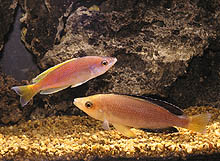
Collected from Nkondwe Island, Tanzania, Cyprichromis
leptosoma “tricolor jumbo” has different male color morphs. Some are
all yellow, and some have the characteristic black fins with an orange-yellow
head and throat. |

Exported from Zambia, the Cyphotilapia frontosa
“blue Kapampa” or “true blue” is trickling out of Congo. |
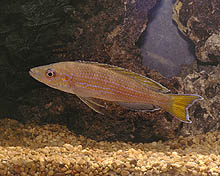
From Kipili, Tanzania, Paracypri- chromis brieni
sports
pin stripes and a yellow tail fin. |
Lake Malawi
Exports from Lilongwe (Malawi) struggled during the aftermath of the
September 11th crisis; however they (happily) were able to resume in November.
Limited collections have begun again in Mozambique, along with the normal
Malawi fish collecting. Tanzanian exports have increased for the
moment. Florida and Far East breeders also have plentiful stocks.

Reportedly from Nkhata Bay, Malawi, an “edwardi-type”
Cynotilapia
afra sports an unusual yellow forehead and dorsal markings. |

A rarely exported egg stealer, Hemitaeniochromis
insignis is from northern Tanzania. Note the specialized
mouth shape. |

Collected in Mozambique, Placido- chromis electra
or “deep water hap” is now available from these shores. |
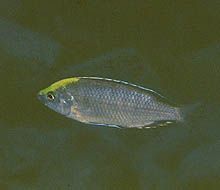
Another difficult-to-find cichlid which can be collected
only in the breeding season, Copadichromis sp. “mloto gold crest
Makonde” is available from Tanzania. |

Not exported from Tanzania in large numbers until
now, Copadichromis borleyi “Kirondo” is an orange variety with white
fin markings. |
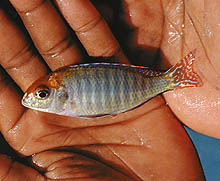
A difficult-to-find beauty, Lethrinops sp.
“red cap” was discovered ten years ago from the extreme northern tip of
the lake in Tanzania and has now made a second debut. Photo by C.
Kacirek. |
Victoria
Not much news to report from the Victorian basin, as exports are non-existent
due to conservation fears generated several years ago. In Uganda,
many cichlid varieties exist in large populations which are not in any
danger of over-collecting for the ornamental trade. Hobbyists still
need to re-visit varieties available from specialized breeders.

Exported over ten years ago from Uganda, Haplochromis
sp. “fire” (a wild-caught individual is shown) is still available from
bred sources. |
 Also from Uganda and found in large numbers there, Haplochromis
sp. “ruby green” is only available from breeders now.
Also from Uganda and found in large numbers there, Haplochromis
sp. “ruby green” is only available from breeders now. |
Neotropics
The collecting season is starting to wane in some parts of Brazil and
elsewhere. Imported and bred supplies of Neotropical cichlids are
strong. Seasonal favorites and colorful cichlids seem to make up
the fare for this winter.

Available from breeders, ‘Cichlasoma’ istlanum
hails from the Pacific slope of Mexico. Photo by J. Rapps. |
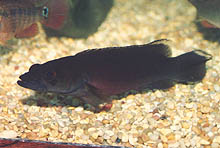
Seasonally available from southern Brazil, Crenicichla
sp. “Xingu III” is a sporadic export. Photo by J. Rapps. |

From Colombia, a new Acarichthys variety has
caught the eye of some specialized hobbyists. Photo by J. Rapps. |
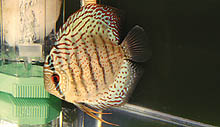
From the Far East, this green Symphysodon discus
sports the desirable red spotting on the body and a high dorsal fin, characteristic
of bred strains from there. |
|











 Also from Uganda and found in large numbers there, Haplochromis
sp. “ruby green” is only available from breeders now.
Also from Uganda and found in large numbers there, Haplochromis
sp. “ruby green” is only available from breeders now.


